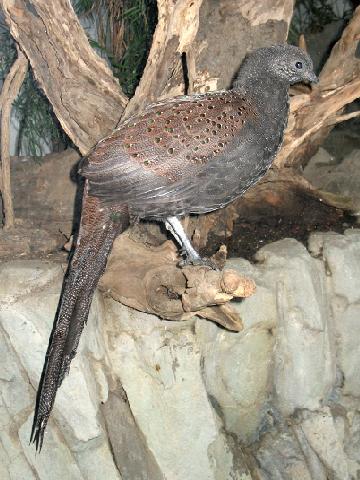- Mountain Peacock-pheasant
Taxobox
name = Mountain Peacock-pheasant
status = VU | status_system = IUCN3.1
trend = down

image_width = 225px
regnum =Animal ia
phylum =Chordata
classis =Aves
ordo =Galliformes
familia =Phasianidae
genus = "Polyplectron "
species = "P. inopinatum"
binomial = "Polyplectron inopinatum"
binomial_authority = (Rothschild, 1903)
synonyms ="Chalcurus inopinatus" Rothschild, 1903The Mountain Peacock-pheasant, "Polyplectron inopinatum" also known as Rothschild's Peacock-pheasant or Mirror Pheasant is a medium-sized, up to 65cm long, blackish brownpheasant with small ocelli and long graduated tail feathers. Both sexes are similar. The male has metallic blue ocelli on upperparts, green ocelli on tail of twenty feathers and two spurs on legs. Female has black ocelli on upperparts, unspurred legs and tail of eighteen feathers. The female is smaller and duller than male.A shy and elusive bird, the Mountain Peacock-pheasant is distributed and endemic to mountain forests of central
Malay Peninsula . The diet consists mainly of berries, beetles and ants.mtDNA cytochrome "b" andD-loop as well as the nuclearovomucoid intron G data confirms that this species belongs to aclade together with theBronze-tailed Peacock-pheasant , but also the mainland speciesGermain's Peacock-pheasant andGrey Peacock-pheasant (Kimball "et al." 2001).The molecular data suggests - though not with high confidence - that this species diverged from mainland stock earlier than the Bronze-tailed Peacock-pheasant. This is quite spurious, since its
biogeography and derived plumage, and the fact that it is a peninsular mountain endemic indicate it is derived from a fairly smallfounder population ; this would confound molecular analyses. What seems clear is that the present species evolved from mainland Southeast Asian stock, probably during theLate Pliocene toEarly Pleistocene (3.6-1 mya [Note that themolecular clock calibration method used by Kimball "et al." (2001) is now known to be inappropriate, yielding far too low estimates in galliform birds.] ). The unique pattern of wings and tail thus is, contrary to long-held opinion, anautapomorphy , and the southern species of this clade - formerly separated in the genus "Chalcurus" - are probably not each other's closest relatives.Due to ongoing habitat loss, small population size and limited range, the Mountain Peacock-pheasant is evaluated as Vulnerable on the
IUCN Red List of Threatened Species. It is listed on Appendix III ofCITES inMalaysia .References
* Database entry includes a range map and justification for why this species is vulnerable
* Kimball, Rebecca T.; Braun, Edward L.; Ligon, J. David; Lucchini, Vittorio & Randi, Ettore (2001): A molecular phylogeny of the peacock-pheasants (Galliformes: "Polyplectron" spp.) indicates loss and reduction of ornamental traits and display behaviours. "Biol. J. Linn. Soc." 73(2): 187–198. [http://www.ingentaconnect.com/content/els/00244066/2001/00000073/00000002/art90536 HTML abstract]Footnotes
External links
* ARKive - [http://www.arkive.org/species/GES/birds/Polyplectron_inopinatum/ images and movies of the Mountain Peacock-pheasant "(Polyplectron inopinatum)"]
* [http://www.birdlife.org/datazone/species/index.html?action=SpcHTMDetails.asp&sid=276&m=0 BirdLife Species Factsheet]
* [http://www.rdb.or.id/detailbird.php?id=221 Red Data Book]
Wikimedia Foundation. 2010.
